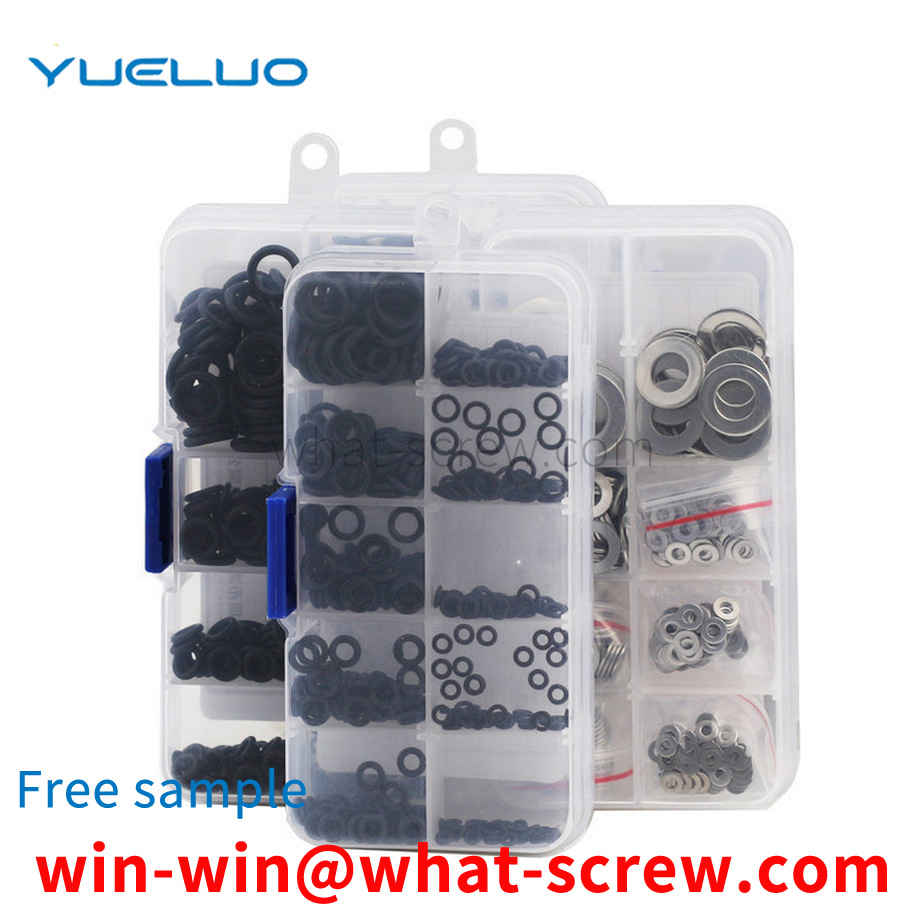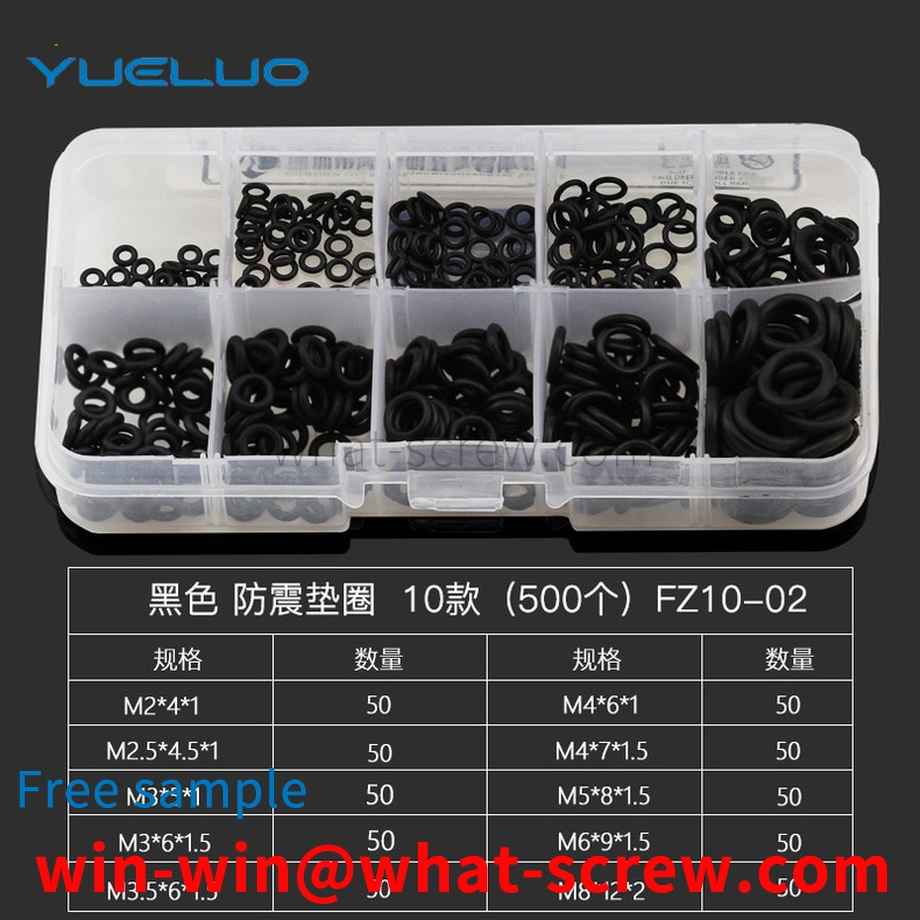The spring washer usually includes a washer body and a raised claw head punched and formed on the washer body. The spring washer is often placed between the bolt head of the bolt and the connected parts, wherein the raised claw head is connected to the part to be connected. The surfaces of the connecting parts are in contact, and the plane on the gasket body, opposite to the lifting direction of the raised claw head, is in contact with the bolt head. After the bolt head is tightened, the elastic reaction force generated by the raised claw head after flattening makes the The screwed threads are pressed tightly, and at the same time, the raised claw head is pressed against the bolt head and the supporting surface of the connected parts, which has the effect of preventing loosening. However, the traditional spring washer is a single-claw type. When tightening, the raised claw head will cause great damage to the surface of the connected parts, so it is not suitable for the anti-loosening treatment of parts with small surface hardness.
Existing bolt and nut connections usually use threads for connection, and this connection method has two main drawbacks. First, tools are required to be used to lock it during installation, and it takes a long time to complete, which is time-consuming and labor-intensive; Second, the installed bolts and nuts are prone to loosening after a period of time, resulting in loosening and shaking between the connecting parts. Therefore, there is a need for a bolt and nut fastener that is easy to install and can effectively prevent the loose fit of the bolt and nut, so as to solve the problems existing in the prior art.
GB6177 Hexagon Flange Nuts - Grade GB55 Hexagon Thick Nuts GB56 Hexagon Extra Thick Nuts GB1229 Large Hexagon Nuts (High Strength for Steel Structure) Lock Nuts Other Names: Root Nuts, Lock Nuts, and Nuts. Purpose: To lock the outer joint of the through wire or other pipe fittings. The working principle of the nut is to use the friction between the nut and the bolt for self-locking. However, the reliability of this self-locking is reduced under dynamic loads. In some important occasions, we will take some anti-loosening measures to ensure the reliability of the nut locking. Among them, the use of lock nuts is one of the anti-loosening measures.
In machine tool processing, it is often necessary to calibrate and debug the probe. The method of manually correcting the detection is inefficient and the accuracy is unstable. In addition, accidents such as collisions will occur. However, calibration tools such as ring gauges are expensive, have large working strokes and poor versatility. Technical realization elements: In view of the above content, it is necessary to provide a positioning pin for probe calibration to solve the above problems. A positioning pin is used for calibrating a probe, the positioning pin includes a connected cylinder and a cylinder, the cylinder is used to be installed on a jig in a machine tool, and the end of the cylinder away from the cylinder is provided with a measuring hole to calibrate the probe. Further, the positioning pin is also provided with a chip removal hole, one end of the chip removal hole is connected to the measuring hole, the other end of the chip removal hole penetrates the end of the cylinder away from the cylinder, and the chip removal hole is used for discharging machining chips and cutting fluid. Further, the diameter of the chip removal hole is smaller than the diameter of the measuring hole. Further, the positioning pin further includes a positioning piece, the positioning piece includes a base and a magnetic piece, one end of the base is provided with a mounting hole for installing the magnetic piece, and the other end of the base is provided with a limiting hole for mounting the column. Further, the limiting hole communicates with the mounting hole. Further, the limiting hole is a blind hole. Further, the diameter of the cylinder is larger than the diameter of the cylinder. Further, the measuring hole is a cylindrical hole. Further, the diameter of the cylindrical hole is 4 mm. Further, the end face of one end of the cylinder provided with the measuring hole is a curved surface, and the end faces the peripheral wall of the cylinder to bend and transition to connect the peripheral wall. The positioning pin of Guangdong Yueluo Hardware Industry Co., Ltd. uses the measuring hole to carry out the probe. It is easy to operate, simple in structure and highly versatile. BRIEF DESCRIPTION OF THE DRAWINGS FIG. 1 is a perspective view of a positioning pin of an embodiment of Guangdong Yueluo Hardware Industry Co., Ltd. FIG. 2 is a three-dimensional schematic view of the positioning pin shown in FIG. 1 without a positioning member. FIG. 3 is an exploded schematic view of the positioning pin shown in FIG. 1 . FIG. 4 is a cross-sectional view of the positioning pin shown in FIG. 1 along the line IV-IV. Description of main components and symbols Locating pin 100 Cylinder 10 Measuring hole 11 Chip removal hole 12 Cylinder 20 Positioning piece 30 Base 32 Mounting hole 321 Limiting hole 323 Magnetic piece 34 The following specific embodiments will be further described in conjunction with the above drawings Guangdong Yueluo Hardware Industrial Co., Ltd. DETAILED DESCRIPTION OF THE PREFERRED EMBODIMENTS The technical solutions in the embodiments of Guangdong Yueluo Hardware Industry Co., Ltd. will be clearly and completely described below with reference to the accompanying drawings in the embodiments of Guangdong Yueluo Hardware Industry Co., Ltd. Obviously, the described embodiments are only Some examples of Guangdong Yueluo Hardware Industry Co., Ltd. are not all examples. Based on the embodiments in Guangdong Yueluo Hardware Industry Co., Ltd., all other embodiments obtained by those of ordinary skill in the art without creative work belong to the protection scope of Guangdong Yueluo Hardware Industry Co., Ltd. It should be noted that when an element is referred to as being connected to another element, it can be directly connected to the other element or intervening elements may also be present. When an element is referred to as being disposed on another element, it can be directly disposed on the other element or intervening elements may also be present. Unless otherwise defined, all technical and scientific terms used herein are related to those of Guangdong Yueluo Hardware Industry Co., Ltd.
With the continuous improvement of road facilities, guardrails are set up in the middle of the roads in most cities at the separation of the upper and lower lanes. At the same time, guardrails are also set up between the motor vehicle lane and the non-motor vehicle lane. The bottom of the guardrail column is set with a base, and the base is usually made of If the steel nail is fixed, the deformation hole should be drilled on the asphalt road first, and then the steel nail should be knocked into the deformation hole. Because the outer wall of the steel nail is cylindrical, the friction force on the ground is small, and the guardrail is affected by the deformation. When the external impact force occurs, the steel nails are easily detached from the asphalt road, making the road guardrail lose its fixation. In some places, expansion screws are used to fix the railings, but during the tightening process of the expansion screws, the expansion pieces are opened by the force of the ejector rod, and the opening angle is small. Limited, the railing will still fall down when subjected to a large impact. Therefore, it is necessary to design a special screw for fixing the railing on the asphalt road.
We have many years of experience in the production and sales of screws, nuts, flat washers, etc. The main products are: cotter pin elastic cylindrical pins, non-standard flange nuts, outer hexagon thin inch nuts, high-strength screw caps and other products, we can provide you with suitable products Your fastener solution.



















 Service Hotline
Service Hotline




